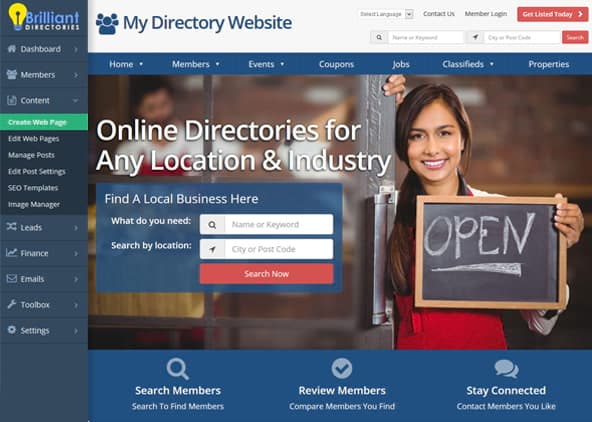
Key Topics:
- 3:03 – Update: Send Emails When Pending Posts are Approved
- 5:25 – Update: Disable Default CSS Stylesheets
- 7:46 – Update: HTML Icons in Page Builder
- 10:45 – Update: Moved Location of Member Review and Lead Settings
- 12:30 – Coming Soon: YouTube & Vimeo Videos in Photo Galleries
- 12:46 – Coming Soon: Show Post Comments Count in Search Results
- 13:11 – Coming Soon: Force-End Your Staff Admin Sessions
- 13:22 – Coming Soon: Pre-Made Content Blocks for Email Templates
- 13:32 – Coming Soon: Compact Logo View on Mobile
- 13:39 – Coming Soon: Ongoing Updates to Make Finding Admin Settings Easier
- 13:53 – New Add-On Coming Soon: Tax & VAT Manager
- 18:10 – Can the word “Tax” on the checkout page be changed via a text label?
- 19:03 – Tip of the Week: 4 Ways to Reduce Friction & Decision Fatigue
- 19:53 – What is Friction & Decision Fatigue?
- 22:04 – 1. Offer 3 Membership Plans at Most
- 23:53 – 2. Simple & Fast Registration Form
- 26:06 – 5 Ways To Optimize Checkout Pages To Increase Membership Sign Ups
- 26:44 – 3. Faster Sign Ups with Facebook/Google
- One-Click Facebook Login
- One-Click Google Login
- 27:59 – 4. Ask for the Bare Minimum of Info
- 31:02 – How To Customize Member Profile Form Fields For Your Target Market
- 32:26 – Why Friction May Be Good
- 37:22 – Can the website theme be changed without altering the website’s data/content?
- 38:11 – Can leads be matched with members automatically? – Automatic Lead Matching add-on
- 43:19 – How does the Brilliant Directories system handle SEO by default?
- 46:22 – Can a member’s profile URL be included in the lead notification emails instead of their contact information?

 AI-Generated Transcript – Please excuse any inaccuracies
AI-Generated Transcript – Please excuse any inaccuracies
Update: Send Emails When Pending Posts are Approved (00:03:03)
- The post moderation add-on allows administrators to send emails to members when their pending posts are approved, providing a way to notify members that their posts are now live and published (00:03:03).
- When a member creates a post, such as an event or article, and the setting requires admin moderation, the post will be in a pending status in the admin area until it is manually approved (00:03:09).
- Administrators can approve pending posts in bulk or manually, and when doing so, they will be prompted to notify the member about the post approval, which will send an email to the member with a link to the approved post (00:03:46).
- The email notification can be enabled or disabled, and if enabled, it will send an email to the member informing them that their previously pending post is now live and published, with a link to the post (00:04:04).
- The email template for post approval notifications can be modified, and it is located in the email templates section, where administrators can filter for “post” and edit the “post approved by admin” template to add a signature or other calls to action (00:04:40).
- The default email template is straightforward, informing the member that their post has been approved and published, and providing a link to the post, but administrators can customize it to fit their needs (00:04:52).
Update: Disable Default CSS Stylesheets (00:05:25)
- The developers can now disable default CSS style sheets that come with Brilliant Directories, which can cause conflicts when creating a landing page, especially when using another template, at (00:05:27).
- There are two settings available to disable the CSS style sheets: one at the page level, which can be found in the display options tab, and one at the site-wide level, which can be accessed through the advanced settings, at (00:05:41).
- At the page level, the setting to disable default CSS style sheets is located in the display options tab and is the last setting available, allowing designers and developers to avoid conflicts and overlaying rules when creating a custom landing page, at (00:06:19).
- When the default CSS style sheets are disabled at the page level, the page will load without the default styles, showing only the HTML, which can be useful for designers and developers who want to create a custom template or theme, at (00:06:28).
- To disable the default CSS style sheets site-wide, users can go to the advanced settings, search for “style sheet”, and select the option to disable the default CSS style sheet, which will apply to the entire site and eliminate the need to disable it on each page, at (00:07:16).
- Disabling the default CSS style sheets site-wide can be useful for designers and developers who are coding their own templates and themes from scratch and want to have full control over the styling of their site, at (00:07:27).
Update: HTML Icons in Page Builder (00:07:46)
- The page builder section now allows users to add icons, with 24 icons currently available, including checks, x’s, stars, and arrows, which are web browser friendly and can be applied with different colors and font sizes (00:07:47).
- These icons can be used to add accompanying text, made different sizes than the text, and can be used to start a sentence or draw attention to important sections of the page (00:07:52).
- The icons can be particularly useful when used in bullet lists, where users can choose from different bullet styles, such as filled-in circles, circles with borders, disks, or squares, or opt for no bullet and use an icon instead (00:09:11).
- Using the “no bullet” option with an icon can help keep bullet lists organized and draw attention to important points, and users can customize the icon’s color and font size to suit their needs (00:09:53).
- The icons can be used to animate the page and make it more engaging, such as using a check mark to indicate included items or a red x to indicate excluded items, and can be used in various creative ways to enhance the page’s content (00:10:28).
Update: Moved Location of Member Review and Lead Settings (00:10:45)
- The location of both the member reviews and the lead settings has been moved, and the new location of these settings can be found in their respective sections, with the lead settings now located in the top right corner of the manage leads section (00:10:45).
- The lead settings used to be located under the manage leads section, but it has been moved up to the top right corner, and this change is intended to make it easier to edit lead settings (00:10:59).
- There are plans to potentially remove or rename the lead section and replace it with an interactions section, which would include features such as chat messages, leads post comments, and potentially member reviews (00:11:21).
- The interactions section would be a more intuitive way to manage how visitors interact with the site, and it would include various features such as chat messages and post comments (00:11:46).
- The member reviews settings used to be edited under the edit post settings, but it has been moved to the member reviews page, where a member review settings button can be found, making it easier to make changes to the review settings (00:11:58).
- The new location of the member reviews settings is more intuitive, and it allows for easier editing of the review settings, which is an improvement over the previous location (00:12:14).
Coming Soon: YouTube & Vimeo Videos in Photo Galleries (00:12:30)
- Upcoming features will allow users to enhance their photo galleries, such as those used when posting a classified, photo album, or product, with new multimedia capabilities (00:12:30).
- These enhancements will enable users to include YouTube or Vimeo videos within their photo slideshows, providing a more engaging experience (00:12:32).
- The integration of YouTube and Vimeo videos into photo galleries will be a new feature, expanding the types of media that can be showcased in these galleries, including classifieds, photo albums, and products (00:12:38).
Coming Soon: Show Post Comments Count in Search Results (00:12:46)
- The post comments add-on currently allows users to show the comments count on the specific posts page (00:12:46).
- A new setting is being developed to display the comments count in the search results, enabling users to see the number of comments a post has received while viewing search results (00:12:52).
- This upcoming feature will provide users with the ability to view the comments count for various types of posts, such as articles, job posts, or events, directly in the search results (00:12:58).
Coming Soon: Force-End Your Staff Admin Sessions (00:13:11)
- The feature to force-end staff admin sessions is upcoming and has been in development for a significant amount of time (00:13:11).
- This feature is currently next in the QA list, indicating that it is nearing release (00:13:14).
- The release of this feature is expected to happen soon, as it is positioned to be launched after passing the QA stage (00:13:15).
- The development of this feature has been ongoing since early 2021, with the release now imminent (00:13:17).
- The exact release time is anticipated to be at the beginning of 2021, but considering the context, it seems the release might be happening after that initial mention (00:13:20).
Coming Soon: Pre-Made Content Blocks for Email Templates (00:13:22)
- Pre-made content blocks are available for landing pages and are nearly ready to be released for email templates, allowing users to build out newsletters more easily (00:13:23).
- The upcoming release of pre-made content blocks for email templates will provide a more efficient way to create newsletters (00:13:27).
- The pre-made content blocks will include a compact option, which will be a useful feature for building out email templates (00:13:31).
Coming Soon: Compact Logo View on Mobile (00:13:32)
- A compact logo view on mobile is being introduced, which is expected to save some important real estate (00:13:35)
- The compact logo view is intended to optimize the use of space on mobile devices (00:13:38)
- The new logo view will provide a more efficient use of screen space, and this feature is currently listed as coming soon (00:13:38)
Coming Soon: Ongoing Updates to Make Finding Admin Settings Easier (00:13:39)
- Ongoing updates are being made to improve the overall experience, with multiple updates planned for the future (00:13:40).
- These updates are part of a continuous process, with several changes and improvements expected to be implemented (00:13:42).
- A few key updates are scheduled to be released, although the exact details of these updates are not yet fully specified (00:13:44).
- An additional update, referred to as a “bonus thing,” is also planned, which will be shared with users before the tip of the week (00:13:46).
- The tip of the week will be presented after sharing the new update, which is expected to provide valuable information to users (00:13:51).
New Add-On Coming Soon: Tax & VAT Manager (00:13:53)
- A new add-on, called Tax and VAT Manager, is coming soon to help manage tax and VAT rules for international users, particularly those in countries like the UK, Canada, and Australia, where tax rules can be complex (00:13:54).
- The Tax and VAT Manager add-on will be part of the VIP add-ons club and can be added to any site, allowing users to set location-based tax rules based on the country and/or state of the customer’s credit card billing address (00:13:56).
- The tax rules will be applied to the order summary at checkout, with the user seeing their subtotal and any applicable taxes, such as primary and secondary taxes, which will be added to the total order (00:14:29).
- In the admin area, there will be a dedicated page where users can set tax and VAT rules by location, allowing them to create new tax rules and specify the tax name, countries, and tax rate (00:15:22).
- Users can choose whether the tax rules will be exclusive, adding the tax on top of the total, or inclusive, adjusting the subtotal to include the tax while keeping the total price the same (00:16:39).
- The system will automatically calculate the tax and adjust the subtotal accordingly, ensuring that the customer does not pay more than the listed price (00:17:33).
- The Tax and VAT Manager add-on is expected to be released in mid-January 2021, and it will be connected to the billing address of the customer’s credit card, assuming that is where they should be taxed (00:18:03).
Can the word “Tax” on the checkout page be changed via a text label? (00:18:10)
- The question of whether the word “Tax” on the checkout page can be changed via a text label was raised by Scott, with the possibility of changing it to something like “marketing co-op contribution” (00:18:10).
- The term “Tax” on the front end of the checkout page is not just one text label, but rather it is per tax rule, allowing for the choice of a nickname that will be displayed (00:18:33).
- The nickname chosen for the tax rule will be shown on the front end of the checkout page, giving the option to use a term like “co-op” or any other preferred term (00:18:35).
- The ability to customize the term for each tax rule provides flexibility in presenting the information to users (00:18:42).
- A snapshot of the settings will be posted in the Facebook group to provide further clarification on the matter (00:18:55).
Tip of the Week: 4 Ways to Reduce Friction & Decision Fatigue (00:19:03)
- The topic of discussion is ways to reduce friction and decision fatigue, particularly when members are signing up to a site, with the goal of simplifying their decision-making process and getting them signed up more quickly (00:19:09).
- Reducing friction is important because it can lead to abandoned sign-ups, similar to abandoned checkouts or shopping carts on e-commerce sites, and the goal is to make the sign-up process as easy and smooth as possible (00:19:36).
- The concept of reducing friction applies to membership directories, where instead of products, there are membership plans, and the aim is to streamline the sign-up process (00:19:44).
What is Friction & Decision Fatigue? (00:19:53)
- Friction can lead to decision fatigue, which is the difficulty added to the member sign-up process on websites, and this difficulty can lead people away from the site and prevent them from signing up (00:19:53).
- Some factors that can contribute to friction include having a sign-up page that is difficult to find, having too much information on the sign-up page, and using too much verbiage, making it easy for people to get lost and ultimately decide not to sign up (00:20:24).
- Offering too many membership plans can also be a pitfall, as it can make the decision-making process more difficult for potential members, similar to being overwhelmed by a large menu at a restaurant (00:20:57).
- Requiring more than just an email address and password for people to register can also create friction, and it is recommended to only ask for essential information initially and then request additional information later (00:21:14).
- The goal is to make the sign-up process as easy as possible and avoid the paradox of choice, which occurs when too many choices are offered and people may end up not making a decision (00:21:45).
- To achieve this, it is important to narrow down options, make the sign-up page easy to find and understand, and only ask for necessary information, allowing people to sign up quickly and easily (00:21:11).
1. Offer 3 Membership Plans at Most (00:22:04)
- Offering three membership plans at most is recommended, as too many choices can be confusing and overwhelming for prospective members, and this approach generally works well for most industries and target demographics (00:22:04).
- The decision to limit membership plans to three is based on the idea of avoiding decision fatigue, which can set in when there are too many options, and making the decision process a no-brainer for prospective members (00:22:35).
- Providing fewer options allows prospective members to make a decision and sign up faster, and it is essential to only advertise the most important features of the membership plan, rather than overwhelming them with unnecessary details (00:22:44).
- When creating a membership plan, it is crucial to focus on the specific features that make it stand out from other websites or membership plans, and to narrow down the sign-up page to the essential features that people want and need (00:23:31).
- By highlighting the important features and minimizing unnecessary details, the sign-up page can be made more concise and less overwhelming, making it easier for prospective members to make a decision and sign up (00:23:40).
2. Simple & Fast Registration Form (00:23:53)
- The goal of the simple and fast registration form is to allow members to register as quickly as possible, with the initial registration process only requiring an email and password for free membership accounts (00:23:55).
- For paid membership plans, additional form fields will be included to collect payment information, such as credit card or debit card details, but it is recommended to keep the sign-up forms as short as possible (00:24:27).
- The registration form should be designed to reduce friction and make the process as smooth as possible, with the ultimate goal of getting the member account created quickly and easily (00:24:51).
- When offering multiple membership plans, it is essential to keep the registration pages short and direct, and to facilitate the registration process as smoothly as possible once the user has made the decision to register (00:25:14).
- The ideal approach is to get the user to the registration page as quickly as possible, but only after they have seen a few motivating assets, and with a minimum number of input fields required to complete the registration process (00:25:47).
- The key is to make the registration process as easy and fast as possible, with the initial registration only requiring basic information, and then allowing for additional information to be collected later (00:26:01).
5 Ways To Optimize Checkout Pages To Increase Membership Sign Ups (00:26:06)
- To optimize checkout pages and increase membership sign ups, adding confidence boosters can be an effective strategy, which was previously discussed in a tip of the week (00:26:06).
- Confidence boosters, such as testimonials, can reinforce the decision to sign up and should be used sparingly to avoid complicating the sign up process (00:26:11).
- It is recommended to add only one or two extra confidence boosters to the checkout page, as the goal is to keep the process simple and not introduce any new information that might deter the sign up (00:26:26).
- The use of confidence boosters is intended to support the potential member’s decision to sign up, rather than to introduce new information or complexity to the process (00:26:30).
- By incorporating confidence boosters, such as a testimonial, the checkout page can be optimized to increase the likelihood of a successful membership sign up (00:26:37).
3. Faster Sign Ups with Facebook/Google (00:26:44)
- The next tip for improving the sign-up process is to utilize faster sign-ups with Facebook and Google, which can make the lives of members easier by reducing friction and speeding up the registration process (00:26:44).
- The one-click social login add-on provides a quick and easy registration process for users by allowing them to register with their Facebook or Google account, which they are often already logged into on their computers (00:27:01).
- When a user clicks the Facebook or Google registration button on the registration page, the website will automatically capture their first name, last name, and email address, making the registration process faster (00:27:20).
- In the future, when the user returns to the site and wants to log in, they can simply click the “log in with Facebook” or “Google” button, whichever they registered with, allowing them to log in easily (00:27:35).
- The one-click social login add-on is not necessary but can speed up the registration process, and users who are part of the VIP add-ons club already have access to this add-on (00:27:41).
- If the one-click social login add-on is not activated, users who have access to it may want to consider turning it on to improve the sign-up process (00:27:54).
4. Ask for the Bare Minimum of Info (00:27:59)
- When a new member signs up, it is essential to ask for the bare minimum of information to avoid form fatigue, which can lead to account abandonment, especially if they have only registered for a free account (00:27:59).
- To prevent this, only the absolutely necessary information should be required fields, allowing members to complete their profiles and get listed on the site without being overwhelmed by a long form with numerous questions (00:29:22).
- If additional information is needed, it can be requested in a welcome email or follow-up email, reminding members to complete their profiles and fill out the necessary forms (00:29:55).
- By not making all fields required, new members can be given small wins, which can boost their emotional confidence to continue using the site, as they experience success in completing the different steps (00:30:42).
- Giving members small wins by keeping forms short and easy to fill out can inherently increase their confidence in using the site, as it appears easy to use, and they can complete the different steps successfully (00:30:36).
Customize Member Profile Form Fields For Your Target Market (00:31:02)
- Customizing member profile form fields allows for different fields to be filled out by different membership plans, which may require a bit of extra work (00:31:04).
- The basic members may not be able to see or fill out certain fields, and the information they can provide may not be public on their profile, encouraging them to upgrade to a premium membership (00:31:21).
- The idea is to limit the information that basic or free member signups can fill out, and if they want to add more information to their profiles, they need to upgrade their plan (00:31:44).
- Setting a bare minimum for initial and basic signups is a great idea, and making it a positive thing for members to upgrade, allowing them to decorate their profile with valuable data that potential visitors might want to see (00:32:03).
- Upgrading a membership plan provides members with the ability to add more information to their listings, making their profile more decorated and valuable to potential visitors (00:32:08).
Why Friction May Be Good (00:32:26)
- Embracing a little bit of friction in the sign-up process can be beneficial as it has the potential to pre-qualify users and maintain a higher level of quality within the community, especially for exclusive membership sites or those with a specific niche or target industry (00:32:29).
- Adding friction to the sign-up process can give the feeling of exclusivity, making it more interesting and enticing for some people who may be interested in joining, as long as it’s not too much and is more in line with a vetting process or ensuring users meet certain criteria (00:33:40).
- Introducing friction can get users invested both emotionally and with their time, making them more likely to commit to a premium membership, as they’ve already made an investment upfront (00:34:57).
- Strategically introducing a little bit of friction or red tape into the sign-up process may be beneficial depending on the goals of the membership site and community, and can be as simple as having users fill out a form requesting to join the site (00:35:36).
- Creating friction can be done by manually approving every sign-up, which can allow for a higher price point for the membership plan, as it provides a more hands-on and curated community experience that people are willing to pay a premium for (00:36:35).
- The level of friction introduced should be carefully considered, as it’s not always desirable to make the sign-up process difficult, but rather to add a level of exclusivity and quality control, which can be achieved through a vetting process or ensuring users meet certain criteria (00:34:10).
- The type of friction introduced can vary depending on the industry and expectations, and can be tailored to fit the specific needs and goals of the membership site and community (00:35:48).
Can the website theme be changed without altering the website’s data/content? (00:37:22)
- The website theme can be changed and reverted back to the original theme without compromising any of the graphics or the layout that was done previously (00:37:22).
- If changes are made to the design settings, a backup is available, allowing users to revert their design settings up to the last 10 saves that were made (00:37:37).
- The backup option can be used to restore the design settings to a previous version, which is useful if recent changes are not satisfactory, and it will restore the images and everything exactly as they were at a specific point in time (00:37:41).
- The backup feature provides a safety net for users who want to experiment with different design settings, as they can easily revert back to a previous version if they are not happy with the changes they made (00:38:02).
- The design settings can be restored to a previous version using the backup option, which is a useful feature for users who have made multiple changes and want to go back to a previous version (00:38:04).
Can leads be matched with members automatically? Automatic Lead Matching add-on (00:38:11)
- The lead generation feature allows members to contribute to the website, and there’s an option to automate the process without requiring authorization for every action, which can be achieved with the automatic lead matching add-on (00:38:13).
- The automatic lead matching add-on enables the creation of rules for direct leads, such as when a visitor submits a lead on a member’s profile, and allows the member to purchase or receive the lead, with additional settings for other members in the same location and category (00:38:41).
- The automatic lead matching feature can be set up to allow multiple members to purchase the same lead, with a maximum number of allowed purchases per lead, and emails can be edited to set the right expectations for members and visitors (00:39:23).
- The email templates can be modified to let visitors know that they may be contacted by multiple professionals, and to let members know that purchasing a lead is not a guarantee for a job, but an opportunity (00:39:50).
- To experience the automatic lead matching feature, it’s recommended to submit a sample lead and see the emails that are generated, which can then be modified in the email templates area if needed (00:40:10).
- The lead settings can be checked to ensure that automation options are enabled, and the auto-match workflows can be reviewed to confirm that the rules are set up correctly (00:40:53).
- The automatic lead matching feature can help reduce admin work by automating the process of matching leads to qualified members, and can be set up to allow members to receive direct leads immediately (00:41:25).
- The “complete preview” option shows the visitor’s email and phone number, whereas the “preview” option only shows the request, and it is recommended to set this to “preview” if you want members to pay for leads (00:41:35).
- When setting up email notifications, copying the admin on the email is likely unnecessary, as they probably receive many indirect leads when matching leads with members who also match the criteria (00:41:50).
- Members should receive direct leads immediately, and the “preview” option is generally the preferred choice, while indirect leads should also be sent to members (00:42:15).
- To automate the lead matching process, the “automatically match leads” option should be set to “yes”, which allows the system to take care of everything as leads come in and notify members via email (00:42:24).
- Additionally, there are third-party SMS options available under “additional notifications” that can send text notifications to members when they receive leads, taking the lead notification system to the next level (00:42:41).
How does the Brilliant Directories system handle SEO by default? (00:43:19)
- The Brilliant Directories system has built-in SEO integration, allowing for granular control over SEO meta tags and templates, including variables such as country name and profession, which can be edited for search results pages (00:43:19).
- The system provides default SEO settings for all pages, including main SEO settings and alt tags for images, so there’s no SEO missing, and users can further customize the default SEO settings if needed (00:44:48).
- The system allows users to designate specific H1 and H2 titles, as well as SEO settings, for individual landing pages created using the web page builder (00:44:32).
- Member profile pages are also optimized for SEO, and members can expect their profile to show up in search results for their name after some time, as long as the site is performing well (00:45:29).
- The default SEO settings provided by the system are sufficient, and users can always enhance them further, but what comes out of the box is already pretty great (00:45:58).
- The system’s SEO capabilities are effective, as evidenced by the fact that image searches and member profile pages can show up in search results, and users can expect good SEO performance without needing to do extra work (00:45:10).
Can a member’s profile URL be included in the lead notification emails instead of their contact information? (00:46:22)
- The discussion revolves around the email notification sent to members when they receive a lead, and whether it’s possible to include a link to the member’s profile page instead of their contact information in the email (00:46:22).
- Currently, the email notification includes the member’s basic information, such as their name and email address, which can bypass the website’s process and allow direct contact (00:46:30).
- The idea is to have the email notification include a link to the member’s profile page, similar to how LinkedIn works when someone connects with another user, to maintain the website’s process and prevent direct contact (00:46:41).
- To achieve this, it’s recommended to email the support team and challenge them with the question, providing an example of the current email template and the desired outcome, which is to include a link to the member’s profile page (00:48:08).
- The support team may have a direct answer or solution to this request, and it’s also suggested to post the discussion in the Facebook group to follow the resolution and gather more feedback (00:48:44).
- The email template in question is called “Lead Visitor Match,” and editing it to include a link to the member’s profile page instead of their contact information might be a straightforward process (00:47:59).
- The goal is to find a solution that works for everyone involved, and the discussion will continue in the Facebook group to explore possible answers and alternatives (00:49:08).














